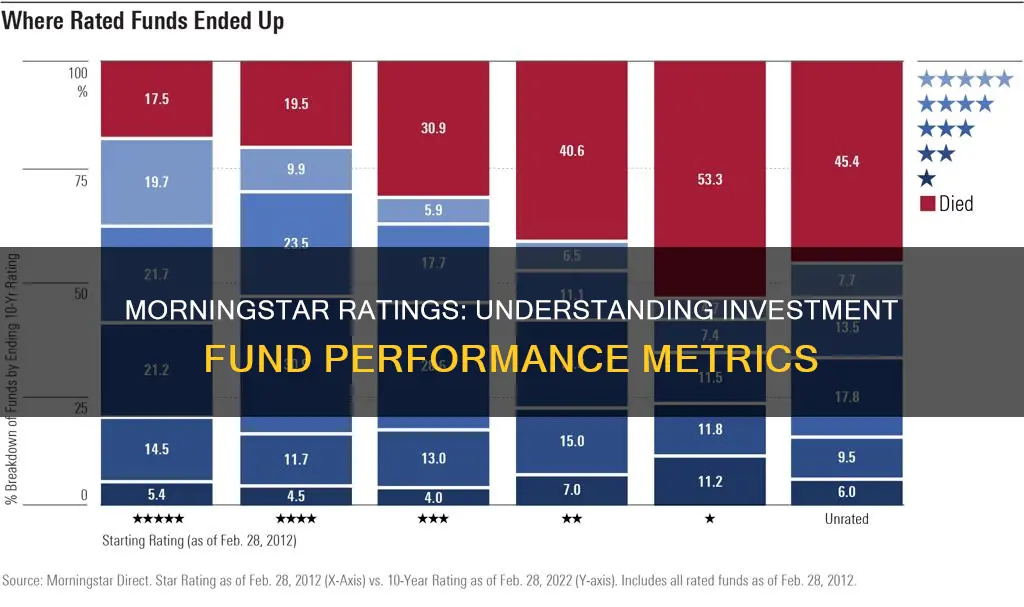
Morningstar is an investment research firm that provides ratings for publicly traded mutual funds and exchange-traded funds (ETFs). The Morningstar Rating, commonly known as the star rating, is a purely quantitative assessment of a fund's past performance, with ratings ranging from one to five stars. The star rating is calculated based on a fund's risk-adjusted return and how it compares to other funds in the same category. While the star rating is a popular tool for investors, it is important to note that it only reflects historical returns and is not a guarantee of future performance. Morningstar also offers other ratings, such as the Morningstar Medalist Rating, which is a forward-looking analysis of investment strategies.
| Characteristics | Values |
|---|---|
| Type of rating | Morningstar Rating (or Star Rating) |
| What it measures | A fund's past performance |
| Scoring | 1-5 stars |
| Scoring criteria | Based on variations in a fund's monthly returns, with an emphasis on downside variations, as compared to similar funds |
| Scoring distribution | Top 10% of funds in a category receive 5 stars; next 22.5% receive 4 stars; middle 35% receive 3 stars; next 22.5% receive 2 stars; bottom 10% get 1 star |
| Scoring frequency | Calculated at the end of every month |
| Scoring history requirement | To receive a Morningstar Rating, a fund must have a record of more than three years |
| Purpose | To help investors assess a fund's track record relative to its peers |
| Other types of Morningstar ratings | Morningstar Medalist Rating, Morningstar Sustainability Rating |
What You'll Learn

Morningstar's star rating system
The star rating is a purely quantitative, backward-looking measure of a fund's past performance. It does not include any forward-looking or predictive elements. The ratings are calculated at the end of every month and are based on a fund's historical performance compared to other like funds. The Morningstar Rating for funds, often called the star rating, compares funds against their peers to inform investment decision-making.
The star rating system is designed to help investors assess a fund's track record relative to its peers. It is intended to be used as the first step in the fund evaluation process. The ratings are based on a fund's past performance, with adjustments for risks and costs, and are calculated using a combination of mathematical formulas and subjective factors. The weighting of the mathematical formula and the classification of a fund into a particular category can impact the final rating.
Morningstar's star ratings are graded on a curve, with the top 10% of funds receiving five stars, the next 22.5% receiving four stars, the middle 35% receiving three stars, the next 22.5% receiving two stars, and the bottom 10% receiving one star. The ratings are not abstract but are instead relative and risk-adjusted. All funds are compared to their peers, and all returns are measured against the level of risk that portfolio managers had to assume to generate those returns.
While Morningstar's star rating system is widely used and regarded, it is not without its critics and limitations. The system only compares funds to other funds, in isolation from the greater marketplace. As a result, a fund's rating may reflect its suitability for a particular market more than its overall viability and potential. Additionally, the star ratings are based solely on a fund's past performance and do not guarantee future results.
A Secure Future: Investing in Provident Funds
You may want to see also

The Morningstar Medalist Rating
Gold-rated funds rank in the top 15% of their category with expected positive net-of-fee alpha. Silver-rated funds rank in the next 35% of products with expected positive alpha. Bronze funds are in the bottom 50% of products that are predicted to have positive alpha. Neutral funds are expected to deliver zero or less than zero alpha, while Negative funds are ranked in the bottom 70% of the category's products with subzero alpha.
Investing in Your 20s: Exchange-Traded Funds for Beginners
You may want to see also

The Morningstar Sustainability Rating
Morningstar is a highly regarded mutual fund and exchange-traded fund (ETF) rating agency. The Morningstar Sustainability Rating is a framework for comparing thousands of mutual funds and ETFs based on environmental, social, and governance (ESG) standards.
Introduced in 2016, the Morningstar Sustainability Rating uses five "globes" to indicate where a fund stands regarding ESG in its industry group, from one (the lowest score) to three (average), and five globes (the highest score). The ratings are issued monthly.
- Determine the fund's suitability for a rating: At least 67% of the companies in the portfolio's assets under management must have an ESG score for the portfolio to get a sustainability score.
- Calculate corporate and sovereign sustainability scores: Two distinct assessments are used to determine corporate and sovereign sustainability scores. The corporate sustainability score represents how much a company's value is affected by ESG factors. The sovereign sustainability score assesses the risk associated with a country's socioeconomic condition and whether it manages its resources sustainably.
- Calculate the historical scores for corporate and sovereign sustainability: Funds that primarily invest in countries with poor sovereign sustainability scores or companies with high corporate sustainability scores generally receive a lower score on the overall sustainability risks in the fund's investment decisions.
- Rank each fund's corporate and sovereign historical sustainability scores: Each fund is rated compared to all scored funds in the same Morningstar category.
- Assign ratings: Morningstar assigns ratings for corporate and sovereign sustainability based on where each fund ranks within its category.
Large-Cap Growth Fund: A Smart Investment Strategy
You may want to see also

How Morningstar ratings are calculated
Morningstar ratings are calculated using a combination of machine learning and human insight. The Morningstar Rating for funds, commonly known as the star rating, is a quantitative, backward-looking measure of a fund's past performance. It is calculated at the end of every month and is based on a fund's risk-adjusted return relative to similar funds. The risk-adjusted return is calculated by subtracting a risk penalty from each fund's total return, accounting for all loads, sales charges, and redemption fees. The risk penalty is determined by the amount of variation in the fund's monthly return, with a greater emphasis on downward variation.
Funds are rated on a scale of one to five stars, with the best performers receiving five stars and the worst performers receiving a single star. The top 10% of funds in a certain category are awarded five stars, the next 22.5% receive four stars, the middle 35% get three stars, the subsequent 22.5% get two stars, and the bottom 10% get one star. Funds are rated for up to three periods: trailing three, five, and ten years. These separate measures are then weighted and averaged to produce an overall rating for the fund.
It is important to note that Morningstar ratings are not intended to be used as a sole selection criterion. They are designed to be the first step in a multi-step process for investors to analyse funds before making a purchase.
UK Index Funds: Where to Invest Your Money Wisely
You may want to see also

Morningstar's ESG Risk Assessment
The ESG Risk Rating Assessment combines the exposure score and the management score to produce an overall score that indicates how at-risk a company's enterprise value is from ESG issues. This rating is an absolute measure of risk, meaning that the scores and ratings are comparable across different issues, companies, and industries.
The rating is depicted by globe icons, with five globes indicating negligible financial risks from ESG issues, and one globe indicating significant ESG risk. Morningstar's ESG Risk Assessment is designed to help investors determine how much exposure a company has to unmanaged ESG risk, as these issues can have a real financial impact. The company believes that ignoring or mishandling ESG issues could lead to significant economic costs that may jeopardize a company's ability to earn long-term, sustainable profits.
In addition to the ESG Risk Assessment, Morningstar also offers a Sustainability Rating for funds, which provides a snapshot of how well ESG risk is managed at the fund level relative to its peer group. This rating is based on Sustainalytics' ESG Risk Ratings and helps investors communicate their ESG performance to wealth managers and retail investors.
Vanguard Star Fund: A Smart Investment Strategy?
You may want to see also
Frequently asked questions
The Morningstar star rating is a ranking given to publicly traded mutual funds and exchange-traded funds (ETFs) by the investment research firm Morningstar. Funds are ranked from 1 to 5 stars, with 1 given to the worst performers and 5 to the best.
The Morningstar star rating is based on a fund's historical performance compared to other like funds. The ranking is based on variations in a fund's monthly returns, with an emphasis on downside variations.
The Morningstar star rating helps investors assess a fund's track record relative to its peers. It is intended to be used as the first step in the fund evaluation process.
Most Morningstar ratings update monthly. Morningstar Medalist Ratings derived by analysts are re-evaluated each year.
The Morningstar Medalist Rating is the summary expression of Morningstar's forward-looking analysis of investment strategies. The rating scale is Gold, Silver, Bronze, Neutral and Negative.







